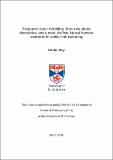Files in this item
Exoplanet transit modelling : three new planet discoveries, and a novel artificial neural network treatment for stellar limb darkening
Item metadata
| dc.contributor.advisor | Cameron, A. C. | |
| dc.contributor.author | Hay, Kirstin | |
| dc.coverage.spatial | xxi, 159 p. | en_US |
| dc.date.accessioned | 2018-11-19T15:16:04Z | |
| dc.date.available | 2018-11-19T15:16:04Z | |
| dc.date.issued | 2018-12-06 | |
| dc.identifier.uri | https://hdl.handle.net/10023/16501 | |
| dc.description.abstract | This first part of this thesis concerns the discovery and parameter determination of three hot Jupiter planets, first detected with by the SuperWASP collaboration, and their planetary nature is confirmed with the modelling of radial velocity measurements and further ground-based transit lightcurves. WASP-92b, WASP-93b and WASP-118b are all hot Jupiters with short orbital periods – 2.17, 2.73 and 4.05 days respectively. The analysis in this thesis finds WASP-92b to have R[sub]p = 1.461 ± 0.077 R[sub]J and M[sub]p = 0.805 ± 0.068 M[sub]J; WASP-93b to have R[sub]p = 1.597 ± 0.077 R[sub]J and M[sub]p = 1.47 ± 0.029 M[sub]J, and WASP-118b to have R[sub]p = 1.440 ± 0.036 R[sub]J and M[sub]p = 0.514 ± 0.020 M[sub]J. The second part of this thesis presents three novel approaches to modelling the effect of stellar limb darkening when fitting exoplanet transit lightcurves. The first method trains a Gaussian Process to interpolate between pre-calculated limb darkening coefficients for the non-linear limb darkening law. The method uses existing knowledge of the stellar atmosphere parameters as the constraints of the determined limb darkening coefficients for the host star of the transiting exoplanet system. The second method deploys an artificial neural network to model limb darkening without the requirement of a parametric approximation of the form of the limb profile. The neural network is trained for a specific bandpass directly from the outputs of stellar atmosphere models, allowing predictions to be made for the stellar intensity at a given position on the stellar surface for values of the T[sub]eff , log g and [Fe/H]. The efficacy of the method is demonstrated by accurately fitting a transit lightcurve for the transit of Venus, and for a single transit lightcurve of TRES-2b. The final limb darkening modelling method proposes an adjustment to the neural network model to account for the fact that the stellar radius is not constant across wavelengths. The method also allows the full variation in light at the edge of the star to be modelled by not assuming a sharp boundary at the limb. | en_US |
| dc.language.iso | en | en_US |
| dc.publisher | University of St Andrews | |
| dc.subject | Astrophysics | en_US |
| dc.subject | Exoplanets | en_US |
| dc.subject | Artificial neural networks | en_US |
| dc.subject.lcc | QB820.H28 | |
| dc.subject.lcsh | Extrasolar planets | en |
| dc.subject.lcsh | Extrasolar planets--Detection | en |
| dc.subject.lcsh | Neural networks (Computer science) | en |
| dc.title | Exoplanet transit modelling : three new planet discoveries, and a novel artificial neural network treatment for stellar limb darkening | en_US |
| dc.type | Thesis | en_US |
| dc.contributor.sponsor | Science and Technology Facilities Council (STFC) | en_US |
| dc.type.qualificationlevel | Doctoral | en_US |
| dc.type.qualificationname | PhD Doctor of Philosophy | en_US |
| dc.publisher.institution | The University of St Andrews | en_US |
This item appears in the following Collection(s)
Items in the St Andrews Research Repository are protected by copyright, with all rights reserved, unless otherwise indicated.

